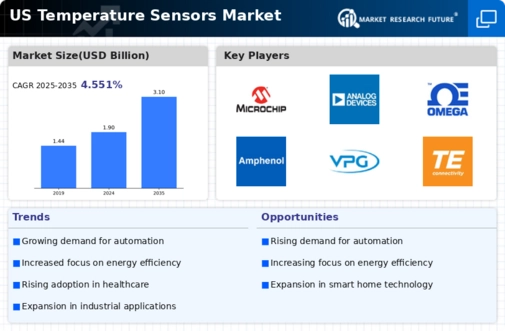Focus on Environmental Monitoring
Environmental monitoring is becoming a crucial driver for the temperature sensors market, particularly in the context of climate change and sustainability efforts. Organizations and governments are investing in temperature sensors to monitor environmental conditions, ensuring compliance with regulations and promoting sustainability initiatives. The market for temperature sensors in environmental applications is projected to grow by 20% by 2025, reflecting the increasing importance of accurate data in addressing environmental challenges. This trend suggests that the temperature sensors market will likely benefit from heightened awareness and investment in environmental monitoring technologies.
Rising Demand in Healthcare Sector
The healthcare sector's increasing reliance on temperature sensors is a notable driver for the temperature sensors market. Hospitals and clinics utilize these sensors for patient monitoring, ensuring accurate readings for critical care. The market is projected to grow as telemedicine and remote patient monitoring become more prevalent. In 2025, the healthcare segment is expected to account for approximately 30% of the total market share, reflecting a growing emphasis on patient safety and care quality. This trend indicates that the temperature sensors market will likely see sustained growth as healthcare providers invest in advanced monitoring technologies.
Emergence of Smart Home Technologies
The rise of smart home technologies is reshaping the temperature sensors market. Consumers are increasingly adopting smart devices that integrate temperature sensors for enhanced home automation and energy management. This trend is expected to drive significant growth in the residential segment, which could account for about 15% of the market by 2025. As homeowners seek to optimize energy consumption and improve comfort, the demand for innovative temperature sensing solutions is likely to increase, indicating a promising future for the temperature sensors market.
Growth in Food and Beverage Industry
The food and beverage industry is a critical driver for the temperature sensors market, as maintaining proper temperature control is essential for food safety and quality. With increasing regulations and consumer awareness regarding food safety, manufacturers are investing in advanced temperature monitoring systems. The market for temperature sensors in this sector is projected to grow by approximately 25% by 2025, reflecting the industry's commitment to compliance and quality assurance. This trend indicates that the temperature sensors market will continue to expand as food producers seek reliable solutions to meet stringent safety standards.
Advancements in Industrial Automation
The push towards industrial automation is significantly influencing the temperature sensors market. Industries are increasingly adopting automated systems to enhance efficiency and reduce operational costs. Temperature sensors play a crucial role in monitoring processes, ensuring optimal conditions for production. In 2025, the industrial segment is anticipated to represent around 40% of the market, driven by the need for precision and reliability in manufacturing. This trend suggests that as industries continue to modernize, the demand for advanced temperature sensing solutions will likely escalate, further propelling market growth.





















Leave a Comment